| |
|
Although
the A134 between Bury and Sudbury is an awful
road, it is easy to escape it, and the hills to
the east of it are Suffolk's prettiest, and full
of pretty villages. These are ancient parishes.
These villages were here before the Norman
conquest, and almost up until the industrial
revolution this was one of the most heavily
populated parts of England. As recently as the
1930s most people in the villages worked the land
around, and a railway line threaded through. But
that is now gone, and to climb the road up from
Sicklesmere is to enter a peace unknown in
Suffolk for centuries.
Little Whelnetham today is little more than two
rows of cottages and houses lining the road to
Bradfield St George, but this is merely
symptomatic of what the second half of the 20th
Century did to rural England. Now, there is no
shop, no post office, nothing except the church
to suggest a sense of community. And, being a
chapel of ease to Bradfield St George rather than
a parish church, St Mary Magdalene hosts just
four services a year. Even some redundant
churches manage more.
It is easy to find evidence of the medieval life
and liturgy of the churches around here, but at
Little Whelnetham (pronounced well-nee-th'm)
there is something even more ancient. Just to the
east of the chancel, set in a mound in the
graveyard, is a low, circular structure about 12
feet in diameter, composed of flint and rubble.
It is almost certainly the base of a round tower,
perhaps part of an earlier church. Round towers
are not common in this part of Suffolk, but there
is one a couple of miles away at Beyton, and
others to the west at Little Saxham and Risby.
The remains here at Little Whelnetham suggest the
possibility that there were once many more of
them. Does it mean that there were once two
churches in this churchyard? Perhaps, for such an
arrangement is not unknown. However, it is more
likely to be a rebuilding, I think. There is no
reason why, I suppose, that a rebuilt church
should be set exactly on the same site as its
predecessor. There is a case for saying that it
might have reused previous foundations, but we
know that a lot of early Suffolk churches were
built without any foundations at all.
In any event, St Mary Magdalene now sits to the
west of what appears to be its former self, and
presents us with a tower that Mortlock thought
older than its apparently 14th century details
would suggest. Simon Cotton, my expert contact on
Suffolk wills and bequests, acknowledges that the
tower is difficult to date. As he points out,
Pevsner suggests a 14th century origin, but the
belfry windows look advanced Perpendicular, and
the brick battlements could easily be early 16th
century. He tells me that the late Peter
Northeast recorded a 1453 bequest by John Dekys'
of 6s 8d to a tower which is highly likely to be
Little Whelnetham. Also, in 1510, John Bunne's
will left 10s to the covering of litill
Queltham stepill. As Simon says, it all
fits, doesn't it? Looking at the nave, Mortlock
went for a 13th or possibly even 12th century
origin, although there's no doubt the whole thing
was given a thorough 14th century going over, and
inside the roof appears to be even later, perhaps
contemporary with the final crowning of the
tower.
As with several churches around here, the
keystone of the late medieval south doorway arch
is fashioned into an angel. You step into a
curious interior, not easily grasped and not
wholly like any other. The first impression is of
a church which is endearingly shabby, without the
polished shine of many Victorianised parish
churches. There is no electricity, and crowns of
candles hang from the nave roof. And part of the
charm of this place is this lovely early 16th
century roof with its hammerbeams and braces. Who
are the crowned figures on the beam ends? Each
one is different. The first instinct is that they
are angels which have lost their wings, but if
these figures ever had wings then they must have
been enormous. And if they are angels, they are
strikingly human ones. They are reminiscent of
the increasingly secular figures on the
contemporary roof miles away at Hockwold in
Norfolk. Could they be drawn from the same
original source, or even be by the same workshop?
Questions, questions. Below them, the lion
corbels stare sullenly down, offering no answers.
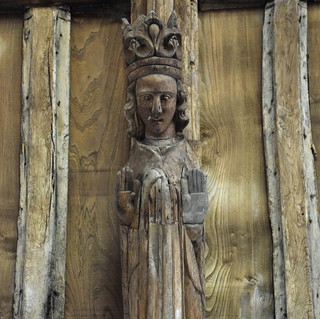 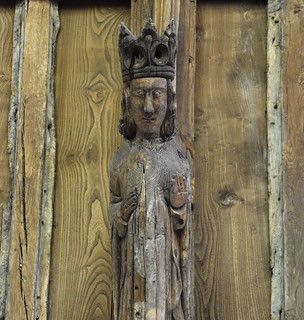
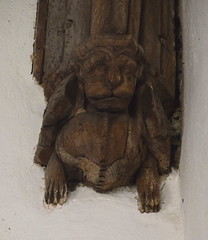 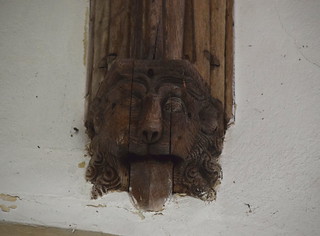 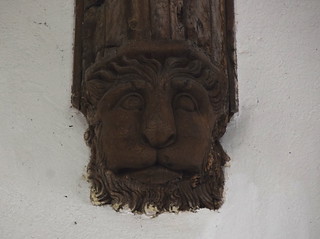
A
17th century bench end depicts a grinning and
undeniably masculine bull, and the initials JB -
almost certainly the seat of a churchwarden
called John or James Bull. There are some image
brackets in the south-east corner of the nave,
which are decorated with foliage and
castellations. And then there is that curious
lectern. I've never seen another one quite like
it. Indeed, judging by the unlikely angle and
obviously added book ledge, Mortlock thought it
might not have been intended as a lectern at all.
In the first years of the 21st Century it had
been severely vandalised, but then repaired so
well that I never would have known if the lady
across the road hadn't told me.
Outside, the view to the west is impressive. St
Mary Magdalene is a hilltop church, suggestive of
an ancient site. A couple of miles off on the
next ridge stands Nowton church, the land falling
away from where you stand and then rising up to
meet it. Out of sight behind you, the church at
Bradfield St George stands a similar distance to
the east. You can't help imagining that these
were once three connected pagan sites of some
significance.
|
|
|

